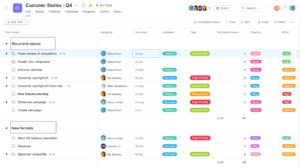If used correctly, PowerPoint is one of the most potent tools a professional can have in their arsenal. While it is often used as a simple “slideshow” presentation tool, if you take the time to understand how to structure and design your PowerPoint presentations properly, you can unlock the potential for maximum impact. For starters, understanding the basics of how to structure and design your presentation can go a long way in making sure it is effective. The following article will provide tips and tricks for unlocking the power of PowerPoint to help you create visually engaging, dynamic presentations that leave lasting impressions on audiences.

Structuring Your Presentation
The first step in creating an effective presentation is defining clear objectives and organizing content into meaningful sections and slides. It’s essential to keep the objective or theme at top-of-mind throughout your entire process when designing visuals—that way, everything works together cohesively instead of feeling disjointed as if multiple topics are being thrown at viewers all at once.
Breaking down complex information into smaller chunks with easy-to-digest visuals like graphs or charts helps make things clearer and easier for your audience to remember after they have left the room. Keep in mind that mapping out key points ahead of time should always be the first point of call before starting any visual design work; this allows you flexibility since layouts and other design elements can be planned to reflect the content better.
Designing Visually Engaging Slides
Once you have an outline of your presentation, it’s time to make sure that the slides look great! One key element in creating a visually appealing PowerPoint presentation is choosing the right color palette—too many colors or too much contrast between text and background can actually distract viewers from what’s important, which is your message.
A simple rule of thumb: Stick with two contrasting colors throughout entire slides for a cohesive look, making use of shades instead if necessary when introducing new topics on separate sliders. Additionally, you can take advantage of templates available online; for instance, if you plan on making a presentation to a group of students, it is easy to simply choose from available education ppt templates and customize the text and image elements to your needs. This way, you can skip the design stage and simply focus on the content.
However, if you are designing everything from the ground up, remember to make your design more appealing by adding relevant images related to your topic; visuals should neither appear over-the-top nor underwhelming neither due to overly relying on solid blocks and plain fonts, as these often tend not to create maximum engagement either way—balancing both will help retain audience attention which would otherwise start dwindling quickly due to a lack interesting visuals.
Enhancing Delivery and Engagement
Now that the presentation is structured correctly with an aesthetically pleasing design, it’s time to get creative! Using slide animations and transitions effectively helps keep viewers engaged throughout your entire talk by creating a sense of dynamism to otherwise “static” slides; there are also other multimedia elements available such as video clips which can be used judiciously where appropriate.
Furthermore, incorporating interactive features like quizzes or polls allow for audience participation so they do not feel left out while being lectured—this has been known to help increase engagement levels even further beyond what conventional presentations tend to achieve when done properly. Be aware of the timing when it comes to presenting content; too much or too little of either can result in a negative experience as one aspect may overshadow another.
Presenting with Confidence and Impact
No matter how visually pleasing your slides are, without proper preparation on delivery and body language, all that hard work could be for nothing! Practicing out loud is key so you don’t stumble over words during the actual presentation; use speaker notes jotted down if necessary but avoid reading them straight from the screen, which tends to create a disconnect between the presenter and the audience, which might kill engagement quickly.
It also helps immensely if vocal techniques, such as volume modulation or pauses at logical points, are used, depending on what type of impact is desired (i.e., powerful vs calming); otherwise, things can come across as monotonous and uninteresting. Additionally, keeping an eye on time is vital for ensuring you cover everything without being too brief or dragging the session out—gauging the audience’s reactions helps to determine whether adjustments are necessary mid-session.
Conclusion
PowerPoint provides many ways of unlocking its potential and creating presentations that leave lasting impressions on audiences; with a little planning ahead coupled with some design work followed by thoughtful delivery techniques and engaging multimedia elements, anyone can create powerful presentations that will have everyone in awe.
As such, understanding how to properly structure your presentation content as well as choosing appropriate color schemes and font combinations while adding visual enhancements like images or graphs are important considerations if maximum engagement is desired from viewers; likewise, using slide animations and transitions effectively while incorporating interactive features also help retain attention when used appropriately. That said, having confidence and preparing accordingly while being mindful of time are crucial for delivering a powerful presentation with maximum impact.
At the end of it all, PowerPoint is an invaluable tool when used correctly; following these tips and tricks should help unlock its potential in creating dynamic presentations that will leave viewers feeling as if they have been on a journey by the time you’ve reached your conclusion—it only takes practice to become adept at using this versatile application.
Taking an online PowerPoint course online is recommended so you can get the best out of the platform. Luckily, we’re in an era where it’s been relatively easy to find the best Excel courses and PowerPoint training programs online.





